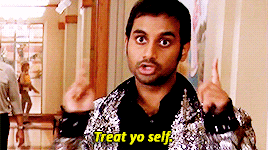Did you know that most people need to save around 15% of what they’re earning now to replace approximately 85% of the income they’ll need in retirement? The percentage varies a little depending on the cost of living a person wants to maintain, but for the most part, it’s true. Yet 40% of Millennials don’t have a single retirement savings account. And a lot of us don’t know where to start.
Thinking about finances and saving for retirement is intimidating in the face of bills, student loans, housing expenses, and everything else that comes with adulthood. But it’s important we start thinking about it—and the sooner, the better, since money compounds more the longer it’s invested. And it’s easier to start than you might think.
These are the steps I’m taking to set myself up for financial success both now and in the future. Everyone’s financial situation is a little different, but if you’re not sure where to start, you can start small with some of these ideas, too.
1. Make a realistic budget… and then actually stick to it
Budgeting seems daunting because it sounds (and is) restrictive. It’s true that the goal of a budget is to help you manage your money and save more. But if your budget is not realistic, you probably won’t stick to it, defeating the purpose of crafting a budget in the first place. To make a sustainable budget, start by taking a look at your spending for the previous three months, and figure out what your average spending is on groceries, dining out, health, entertainment, bills, etc. then adjust your spending habits accordingly. Keep track in an Excel spreadsheet, on paper, or with an app like Mint. When I did this, I learned I ate out 240 times in three months. Needless to say, I shifted that habit very quickly once I was aware of it.
For the first month, use the average for each category as your budget, and get used to keeping track of what you are spending. From there, make small adjustments where you can cut back, and save the difference or use it to pay off debts. Start small and slow, and you won’t feel like you’re forcing yourself to stop buying everything you love all at once. Keep track in an Excel spreadsheet, on paper, or with an app like Mint. Many banking apps also offer tools to help you budget. Do what works for you and what will be easiest to stick to.
2. Build an emergency savings fund and seek financial coverage
Really, you should think of building a savings fund— that contains at least 3-6 months’ worth of your current expenses, that you do not touch unless you have an actual emergency (like temporary job loss). Unfortunately, shopping emergencies don’t count here). Build it at the pace that you need to (but I’d start with the emergency fund). Even $50-100 a month will add up over time, so no matter how small you start, start somewhere.
While building a savings fund can help you cover minor expenses, there can be some major situations where a fund may not help you and your family. The possibility can be from heavy loss due to theft, property damage or at the worst is the death of the breadwinner of your family. In such circumstances, financial coverages like life insurance policies need to be there for your protection. Whether you should choose term policy or a whole life insurance policy depends on your financial status, possessions, wealth etc. To pick the right option you can seek guidance from a financial advisor to help you understand with clarity.
The sooner you’re able to have a coverage off of your list, the better off—and more prepared—you’ll be.

3. Start a retirement account
If your employer offers a 401k and will match your contributions to it, set your contribution high enough to get the max amount they will match as soon as you are able, because otherwise you’re leaving free money on the table. For example, if your employer will match your contribution rate up to a maximum of 6%, then set your personal contribution to 6% as soon as you can, so you get the full match, too—and you’ll really be banking 12%. Ideally you should do this when you begin a job, because your 401k contribution will automatically deduct from your paycheck without you having to think about it. It also won’t feel like a piece of your income is missing if you weren’t counting on having it in the first place, because you’ll build your budget based on your take-home pay (your pay after taxes and other deductions are taken out), rather than your gross salary.

If your employer doesn’t offer a 401k, you still have options. Many financial companies will let you get you open up a 401k to contribute to, and you can also open a Roth IRA to build retirement funds (but note that Roth IRAs are off the table after you earn a certain amount per year). The key to both options is to start as soon as you can so it will compound for longer. And don’t be afraid to do your research or consult a financial advisor first if you have questions.
4. Take steps to protect your income.
When you buy a car or a house, you buy insurance for it. So when you think about how hard you work every day to earn your income, protecting it like you protect everything else should be a no-brainer. At least, it was for me. It’s easy to think “It won’t happen to me” when it comes to being too sick or hurt to work, but it happens more often than you think—from cancer to car accidents and many things in-between—and those events can wipe out your entire savings quickly.
Individual Disability Insurance is one way you can protect your income, because it helps to cover expenses if you’re unable to work due to a disability. And if you’re thinking “that’s nice, but insurance is expensive,” think again. A lot of policies cost around one to three percent of your income, which is about the same per month as what you eating out once or twice a week (the price does vary some based on your income, age and health). It’s something worth considering, especially while you’re setting yourself up for financial success in so many other ways. Another option is looking into special needs financial planning to see what works best for you.

5. Leave room to treat yourself
Lastly, leave some money to do the things that make you happy. It’s important to save for retirement and take steps to set yourself up for financial success, but it’s also important to enjoy your life while it’s happening. Set aside some money for an entertainment budget. Leave room for a monthly date night. Let yourself splurge once in awhile on a fancy dinner out or that new top you’ve been eyeing. Build a travel fund into your budget so you’re able to get away when you need to. Just don’t let the phrase “treat yo self” get out of hand, and you’ll stay on the right path.

Share this:
- Click to share on Tumblr (Opens in new window)
- Click to share on Twitter (Opens in new window)
- Click to share on Facebook (Opens in new window)
- Click to share on Reddit (Opens in new window)
- Click to email a link to a friend (Opens in new window)
- Click to print (Opens in new window)
- Click to share on Pocket (Opens in new window)
- Click to share on LinkedIn (Opens in new window)
- Click to share on Pinterest (Opens in new window)







